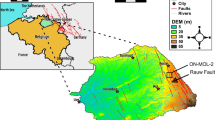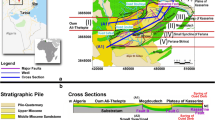Abstract
Groundwater models which realistically represent the hydrogeology of a complex system, like the Unkheltseg Basin, are critically important to Mongolia. They have flow on benefits to research, governments, management strategies and commercial development within the country. Limited case studies of calibrated 3-D numerical transient simulations in fault-controlled connection between basins, similar to the Unkheltseg Basin, are available in the public domain and the model presented here aims to address this problem. This basin is uniquely geologically controlled and a key water supply resource for future economic development in the Taikh Valley. Commercial exploration projects have produced the high-quality geological and hydrogeological data gathered, necessary for successful model simulation at a basin-wide scale. Using the “DRAIN Package” and “Fracture-Well Package FW4” in MODFLOW-SURFACT, the spatial discretization necessary to fully represent horizontal and vertical flow direction was achieved to effectively constrain recharge and discharge across the fault barrier. This model is an important tool for establishing a long-term monitoring programme in a fault-controlled basin, which predicts regional impacts, both short and long term.









Similar content being viewed by others
References
Allen DM, Michel FA (1999) Characterizing a faulted aquifer by field testing and numerical simulation. Groundwater 37(5):718–728
Barnett B, Townley LR, Post V, Evans RE, Hunt RJ, Peeters L, Richardson S, Werner AD, Knapton A, Boronkay A (2012) Australian groundwater modelling guidelines, Waterlines report. National Water Commission, Canberra
Battumur (2009) Assessment of water supply options for proposed Bayan Airag gold–copper mine
Bense VF, Gleeson T, Loveless SE, Bour O, Scibek J (2013) Fault zone hydrogeology. Earth Sci Rev 127:171–192
Beven KJ, Kirkby MJ (1979) A physically based variable contributing area model of basin hydrology. Hydrol Sci Bull 24:43–69
Bidwell VJ, Stenger R, Barkle GF (2008) Dynamic analysis of groundwater discharge and partial-area contribution to Pukemanga Stream, New Zealand. Hydrol Earth Syst Sci 12:975–987
Bredehoeft JD (1997) Fault permeability near Yucca Mountain. Water Resour Res 33(11):2459–2463
Bredehoeft JD (2005) The conceptualization model problem-surprise. Hydrogeol J 13:37–46
Cello G, Gambini R, Mazzoli S, Read A, Tondi E, Zucconi V (2000) Fault zone characteristics and scaling properties of the Val d’Agri fault system (Southern Apennines, Italy). J Geodyn 29(3–5):293–307
Danis C (2012) Sydney–Gunnedah–Bowen Basin deep 3-D structure. Explor Geophys 43:26–35. doi:10.1071/EG11043
Doherty J, Simmons TC (2013) Conceptual modelling in decision support; reflections on a unified conceptual framework. Hydrogeol J 21:1531–1537
EcoTrade (2007) Bayan Airag Environmental and Social Baseline Report, Zavha Aimag, Southern Mongolia
Evans JP, Forster CB, Goddard JV (1997) Permeability of fault-related rocks, and implications for hydraulic structure of fault zones. J Struct Geol 19:1393–1404
Fetter CW (1994) Applied hydrogeology, 3rd edn. Prentice Hall, Upper Saddle River
Fiorillo F (2011) Tank–reservoir drainage as a simulation of the recession limb of karst spring hydrographs. Hydrogeol J 19:1009–1019
Folch A, Mas-Pla J (2008) Hydrogeological interactions between fault zones and alluvial aquifers in regional flow systems. Hydrol Process 22:3476–3487
Freeze RA, Cherry JA (1979) Groundwater. Prentice Hall Inc, Upper Saddle River
Gupta HV, Clark MP, Vrugt JA, Abramowitz G, Ye M (2012) Towards a comprehensive assessment of model structural adequacy. Water Resour Res. doi:10.1029/2011WR011044
Harbaugh AW, Banta ER, Hill MC, McDonald MG (2000) MODFLOW-2000, the US Geological Survey modular ground-water model—user guide to modularization concepts and the ground-water flow process, Open File Report. OFR00-92, US Geological Survey, Denver, Colorado, pp 121
Hasiniaina F, Zhou J, Guoyi L (2010) Regional assessment of groundwater vulnerability in Tamtsag Basin, Mongolia using drastic model. J Am Sci 6(11):65–78
Huntoon PW, Lundy DA (1979) Fracture-controlled ground-water circulation and well siting in the vicinity of Laramie, Wyoming. Groundwater 17(5):463–469. doi:10.1111/j.1745-6584.1979.tb03342.x
HydroGeoLogic Inc. (2002) MODFLOW-SURFACT: a comprehensive MODFLOW-based hydrologic modelling system: code documentation and user’s manual. HydroGeoLogic Inc., USA
Kampf SK, Burges SJ (2007) A framework for classifying and comparing distributed hillslope and catchment hydrologic models. Water Resour Res 43:W05423. doi:10.1029/2006WR005370
Kazemi GA (2012) Hydrogeology—a global perspective. InTech publishing company, Rijeka. ISBN: 978-953-51-0048-5
Kresic N, Mikszweski A (2014) Hydrogeological conceptual site models data analysis and visualization. Environ Earth Sci 72:623. doi:10.1007/s12665-014-3268-8
Lopez DL, Smith L (1996) Fluid flow in fault zones: influence of hydraulic anisotropy and heterogeneity on the fluid flow and heat transfer regime. Water Resour Res 32:3227–3235
McDonald MG, Harbaugh AW (1988) A modular threedimensional finite-difference ground-water flow model. USGS Techniques of Water-Resources Investigations Book 6, Chapter A1
Middlemis H (2004). Benchmarking best practice for groundwater flow modelling. The Winston Churchill Memorial Trust of Australia
Nelson ST, Mayo AL (2014) The role of interbasin groundwater transfers in geologically complex terranes, demonstrated by the Great Basin in the western United States. Hydrogeol J 22:807–828
Nordqvist AW, Tsang YM, Tsang CF, Dverstorp B, Andersson J (1992) A variable aperture fracture network model for flow and transport in fractured rocks. Water Resour Res 28(6):1703–1713
Nordstrom DK (2012) Models, validation and applied geochemistry: issues in science, communication, and philosophy. Appl Geochem 27:1899–1919
Palma HC, Bentley LR (2007) A regional scale groundwater flow for the Leon-Chinandega aquifer, Nicaragua
Pimentel ET, Hamza VM (2014) Use of geothermal methods in outlining deep groundwater flow systems in paleozoic interior of Brazil. Hydrologeol J 22:107–128
Pulido-velazquez MA, Sahquillo-Herraiz A, Camilo OJ, Pulido-velazquez D (2005) Modelling of stream–aquifer interaction: the embedded multi reservoir model. J Hydrol 313:166–181
Ran G, Eyal S, Yoseph Y, Amir S, Noam W (2014) The permeability of fault zones: a case study of the Dead Sea rift (Middle East). Hydrogeol J 22:425–440. doi:10.1007/s10040-013-1055-3
Reilly TE, Harbaugh AW (2004) Guidelines for evaluating groundwater flow models. US Geological Survey Scientific Investigations Report 2004-5038, 30 p
Rojstaczer S (1987) The local effects of groundwater pumpage within a fault-influenced groundwater basin, Ash Meadows, Nye County, Nevada, USA. J Hydrol 91:319–337
Rupp DE, Schmidt J, Woods RA, Bidwell VJ (2009) Analytical assessment and parameter estimation of a low-dimensional groundwater model. J Hydrol 377:143–154
Schlumberger Water Services (2009) Hydro geobuilder. A flexible, simulator-independent, hydrogeological modelling environment. User’s manual. Waterloo, Ontario, Canada
Schlumberger Water Services (2010) Visual modflow. Dynamic groundwater flow and contaminant transport modelling software. User’s manual. Waterloo, Ontario, Canada
Shan S, Javandel I, Witherspoon PA (1995) Characterisation of leaky faults: study of water flow in aquifer-fault-aquifer systems. Water Resour Res 31(12):2897–2904
Simmons CT, Hunt RJ (2012) Updating the debate on model complexity. GSA Today 22(8):28–29. doi:10.1130/GSATG150GW.1
Singh VP, Woolhiser DA (2002) Mathematical modelling of watershed hydrology. J Hydrol Eng 7:270–292
Sloan WT (2000) A physics-based function for modelling transient groundwater discharge at the watershed scale. Water Resour Res 36:225–242
SMEC (2011) Bayan Airag Gold Project pre-feasibility level mine water supply assessment. Bayan Airag Exploration LLC
SMEC (2012) Bayan Airag Gold Project feasibility level mine water supply assessment. Bayan Airag Exploration LLC
Vandenbohede A, Hinsby K, Courtens C, Lebbe L (2011) Flow and transport model of a polder area in the Belgian coastal plain: example of data integration. Hydrogeol J 19:1599–1615
Voss CI (2011) Groundwater modelling fantasies—part 1, adrift in the details. Hydrogeol J 19:1281–1284
Wenping L, Zhenying L, Haipeng G, Ning L, Weidong K (2011) Simulation of groundwater fall caused by geological discontinuities. Hydrogeol J 19:1121–1133
Yihdego Y, Becht R (2013) Simulation of lake–aquifer interaction at Lake Naivasha, Kenya using a three-dimensional flow model with the high conductivity technique and a DEM with bathymetry. J Hydrol 503:111–122
Yihdego Y, Webb AJ (2014) Use of a conceptual hydrogeological model and a time variant water budget analysis to determine controls on salinity in Lake Burrumbeet in southeast Australia. Environ Earth Sci. http://link.springer.com/article/10.1007/s12665-014-3509-x
Acknowledgments
The authors would like to thank Bill Colvin and the staff of Bayan Airag Exploration LLC for providing permission to publish this work and in the undertaking of the fieldwork for the Pre and Feasibility level assessments. Valuable comments and suggestions by the Editor (James W. LaMoreaux) and two anonymous referees are greatly appreciated.
Author information
Authors and Affiliations
Corresponding author
Rights and permissions
About this article
Cite this article
Yihdego, Y., Danis, C. & Paffard, A. 3-D numerical groundwater flow simulation for geological discontinuities in the Unkheltseg Basin, Mongolia. Environ Earth Sci 73, 4119–4133 (2015). https://doi.org/10.1007/s12665-014-3697-4
Received:
Accepted:
Published:
Issue Date:
DOI: https://doi.org/10.1007/s12665-014-3697-4




